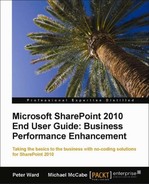We feel that the business community's most logical entry point for the for the SharePoint technology is not a deep dive into the technology, but to identify the typical end users and discuss the information and technology considerations to identify what is possible with this deployed technology with your organization. Most end users will always try to get more work done with their existing tools such as e-mail, Word, and Excel; in reality, these tools have their limitations in terms of personal and team productivity. With the release of the SharePoint technologies in 2001, 2003, and 2010, there has been a tighter integration of the Office applications and corporate web server technologies that have resulted in additional functionality and team processes to the Office applications, such as version control, workflow, and issue tracking.
This chapter will cover the typical end user in an organization and how they currently use information and apply this to their work processes with the SharePoint technology, all without the direction of the IT department. It will also address some frequently asked questions about SharePoint that should be asked by end users. This chapter will cover the following topics:
- The typical end user
- Webinizing information
- Key takeaways
- Technical considerations for an end user
- Integration with other technologies
- External access
- Governance
End users are people who use the SharePoint product, as opposed to those who develop or support it, so it is important that the SharePoint technology adds value to an end user's work day by making tasks more structured within a team, and information easier to find. The end user may or may not know what to do if something goes wrong, or indeed will not usually have administrative responsibilities or privileges. However, it is more their behavior and attitude toward a product such as SharePoint that will make a difference in their day-to-day activities. End users typically fall into the categories described in the following sections:
This is the person who is content with their existing toolset of Word, Excel, and Outlook. Their inbox may be full of unorganized e-mails, and their desktop is overflowing with saved documents. However, the idea of investing time and changing behavior is either completely alien or unwelcome. Using desktop technology to increase productivity will be a challenge if the person is unwilling to learn. Their excuses will range from I'm too busy, It's too difficult to use, or I don't have time. Their effectiveness as a team player in using information is limited and self-imposed as they are unwilling to learn and change their behavior. This kind of a person is a late adopter to a SharePoint deployment. These people are also categorized as Low Touch, Low Adopter. The good news with this kind of end user is that they are honest and will be vocal that they are not using the technology.
This person is supportive in the deployment and understanding of the technology, but that is as far as it goes. What they are really saying is that this technology is great, but for everyone else to use. Their effectiveness as a team player with information is also limited and self-imposed as they also are unwilling to learn and change their behavior. Unfortunately, collaboration requires everyone to be on board for it to work effectively.
This wide-eyed user is eager to learn, willing to change his behavior patterns, and ready to use the quick productivity wins that SharePoint provides. This kind of end user is willing to learn SharePoint functionality, but the steps have to be easy and should not require too much work.
This is your Power User who will typically know how to perform the advanced formulae in Excel and will have a very efficient inbox, by having rules set up, and an organized folder structure. This kind of end user will invest time to advance his knowledge with SharePoint. If anything, they will find that administrative restrictions hold back their use of all of the functionalities.
It is important that an end user (or a trainer) knows what categories they belong to so, they know how to get the most mileage and use from this book. If the reader is honest and recognizes that he is not in the last two categories then this book will only provide an entertaining read. If you are in the last two categories, we urge you to change your daily habits as you learn SharePoint's functionality.
